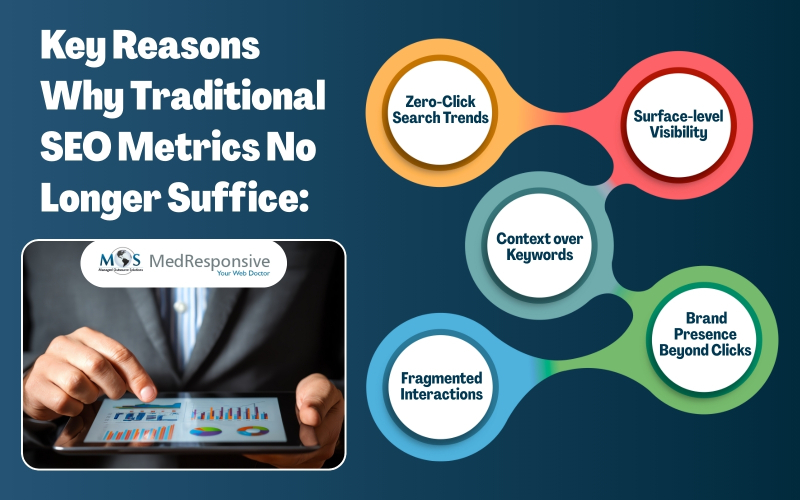Our latest post explores AI visibility metrics—measuring how often your content is cited, summarized, and recommended by AI-driven platforms. These insights help you make smarter, data-driven decisions and boost engagement in today’s AI-first search landscape.
For decades, SEO teams have relied on analytics, detailed reporting, and measurable results to drive informed decision-making and refine marketing tactics. However, with the introduction of AI-powered information portals, the standard for measuring SEO success has changed profoundly. No longer limited to traditional metrics such as click-through rates and keyword rankings, today’s AI-driven search landscape demands new AI visibility metrics shaped by the way LLMs evaluate and rank content.
According to a report by searchengineland.com, nearly 60% of Google queries result in zero-click searches. Another finding by seoclarity.net is that one or more of the top 10 results were included in AI Overview’s sources a staggering 99.5% of the time. These insights underscore the need to understand how AI models interpret intent, context, and authority.
AI-specific metrics capture which pieces are cited in generative answers, their prominence in AI recommendations, and the context in which they appear. By tracking these signals, SEO teams can optimize content for human readers and AI-driven discovery, maximizing visibility across all channels. Businesses that leverage affordable digital marketing services can more easily translate AI insights into actionable SEO improvements for enhanced AI discoverability.
What Are AI-powered SEO Metrics?
AI-driven SEO metrics refer to the set of analytics collected, analyzed, and measured to track the impact of AI-powered platforms on websites. This new dashboard of metrics evaluates how content is seen, understood, cited, and recommended by AI systems. With generative AI search metrics, businesses gain insights into how intelligent systems perceive and assign value to their content.
SEO specialists leverage these indicators to assess social signals that go far beyond user clicks, such as brand visibility, semantic coverage, and domain authority. According to a study by Advanced Web Ranking, Google AI Overviews now appear in more than 50% of user queries. These findings highlight the significance of measuring the impact of AI-driven search results as conventional metrics no longer reveal the full picture.
Why Traditional SEO Metrics Alone No Longer Suffice
Traditional search relies heavily on keyword matching and link-based ranking algorithms to generate a list of linked results. Digital marketers analyzed website performance using conventional SEO metrics such as click-through rates, organic ranking positions, and average session duration. These quantifiable signals provided the clearest path into user behavior, website positions, and conversion rates.
However, with the advent of AI in fragment formats such as search engine, chat interface, and smart voice assistants, these metrics no longer cover the full scope of digital reach. People now seek direct, synthesized responses from AI-powered platforms rather than visiting the results page. This transformative shift in user behavior means traditional measurement methods have largely become outdated, with only few retaining relevance.
Here are key reasons why conventional metrics no longer suffice:
- Zero-Click Search Trends – AI tools deliver synthesized answers instantly, bypassing the need to click a page or visit a site. This translates to zero-click outcomes, where impressions may be high but organic traffic remains low.
- Surface-level Visibility – Traditional metrics focus on page-level rankings and clicks, failing to account for how content is retrieved, mentioned, or referenced by AI summaries.
- Context over Keywords – AI evaluates content based on intent, relevance, and authority rather than simple keyword matches. Metrics that track only rankings or keyword density miss these deeper signals.
- Fragmented Interactions – Users now interact with content across multiple AI touchpoints such as voice assistants, chat bots, and snippet reviews. These interactions make metrics such as session duration or page views insufficient indicators of engagement.
- Brand Presence beyond Clicks – AI visibility emphasizes how often your brand is recognized, cited, or recommended by generative answers, even when users never land on your site. Traditional metrics do not capture this emerging form of digital influence.
Measuring your AI visibility is no longer optional as it directly influences data-driven decision-making, brand authority, competitor benchmarking, and long-term revenue growth potential.
How to Measure AI-powered SEO Metrics Effectively
As generative search and AI-driven platforms reshape how people find information, understanding the factors driving AI visibility score is crucial to improve SEO strategy. AI-powered ranking signals focus on how intelligent systems perceive, reference, and present your content. Monitoring these indicators reveal true digital reach even when no clicks occur, identifying opportunities for buyer discovery, market intelligence, and revenue maximum.
Given below are the key AI-specific metrics to boost online visibility and brand presence for businesses:
- AI Citation Frequency
AI citation frequency measures how often your content is directly cited or sourced within AI-generated responses. A high citation frequency is crucial because it not only shows that language models view your site as authoritative but also drive direct high-intent traffic when users click on responses. It’s one of the clearest indicators of trust from generative engines. Key actionable steps include:
- Develop well-researched, expert-backed thought leadership content with original data and insights.
- Use clear author credentials and citing reputable external references to establish credibility and authority.
- Create consistent, topical content clusters that reinforce niche expertise.
Regularly monitoring citation frequency helps maintain authority and ensures your content remains a trusted source for AI-generated answers.
- Share of Voice in AI Responses
This metric tracks how often your brand is mentioned in AI summaries compared to your competitors. It highlights your relative presence when users receive synthesized answers without visiting a page. This is a key indicator that demonstrates your market position in dense, competitive verticals.
Key actionable steps include:
- Use automated monitoring tools to discover prompts that trigger your brand mentions and citations across AI platforms and conversational interfaces.
- Engage in industry discussions to increase off-site authoritative mentions.
- Conduct content gap analysis and competitor citation source attribution to identify topics where competitors dominate and identify opportunity for content gaps.
Tracking share of voice reveals your competitive standing and guides strategy to strengthen brand presence across AI-driven platforms.
- Semantic Coverage
Semantic coverage evaluates how comprehensively your content addresses user queries, related questions, subtopics, and intent clusters that AI uses to generate answers. Broader coverage signals depth and reliability to large language models, improving the odds of appearing in multiple AI contexts. Key actionable steps include:
- Perform topic mapping to uncover gaps and related keyword clusters.
- Expand existing pages to answer connected questions with thorough explanations.
- Link supporting articles to create a strong internal topical network.
Tracking this score ensures your content fully matches the depth of user intent that AI systems prioritize.
- User Engagement and Conversion Quality
User engagement and conversion quality metric measures the percentage and caliber of users who click through to your site after encountering it in an AI-generated response. Key metrics include time spent on page, scroll depth rate, and return visits which indicate meaningful engagement beyond raw traffic volume. With more selective, higher quality visitors arriving via AI outlets, these indicators reflect how compelling and trustworthy your cited information appears when surfaced by AI. A higher user conversion-quality score signals that your content not only gains visibility but also encourages users to take action. Key actionable steps include:
- Craft concise, user-driven titles and descriptions that encourage clicks.
- Add clear calls to action within AI-friendly content sections.
- Implement schema markup to display rich, attractive preview data.
Monitoring user engagement metric helps you understand how effectively AI visibility converts into meaningful site visits.
- Brand Sentiment Analysis
This metric examines not just how often your brand is mentioned but also the tone and context of those mentions across AI-generated content. Positive or accurate representation strengthens brand trust while negative portrayals can erode authority. Key actionable steps include:
- Monitor AI snippets and summaries regularly for accuracy and sentiment.
- Respond quickly to inaccurate or negative third-party content.
- Highlight positive reviews, testimonials, and authoritative endorsements
.
Consistent sentiment monitoring protects brand reputation and builds consistent brand messaging with AI-driven platforms.
Top Strategies to Maximize Your AI Visibility
Master AI-driven SEO Metrics with Outsourcing Support
As AI-powered search becomes the default search method, businesses need to monitor how their content performs and influences audiences. Brands can partner with AI-proficient outsourcing digital marketing services to implement targeted AI SEO tactics and ensure maximum ROI for your marketing efforts. This ongoing tracking supports smarter, data-driven decision making, ensuring better quality visibility, engagement, and overall performance in AI-driven responses. By translating these insights into a strategic GEO plan, brands can stay discoverable, build lasting authority, and remain competitive as algorithms and user behavior continues to evolve.





